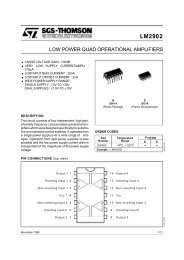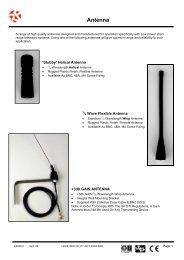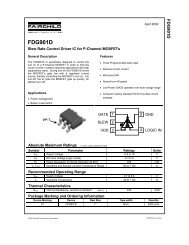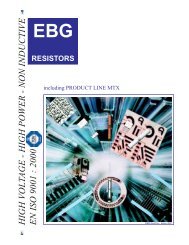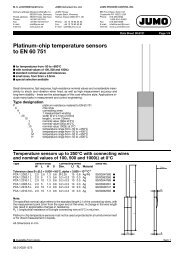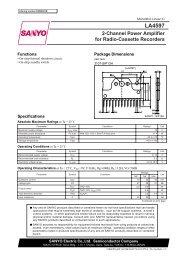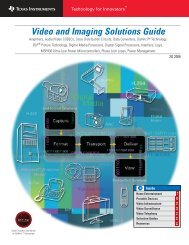Interface Selection Guide
Interface Selection Guide
Interface Selection Guide
Create successful ePaper yourself
Turn your PDF publications into a flip-book with our unique Google optimized e-Paper software.
20 USB Hub Controllers and Peripheral Devices<br />
➔<br />
Universal Serial Bus (USB)<br />
The USB standard defines a bus product<br />
that requires a host controller and<br />
enables plug-and-play connectivity. The<br />
most recently released final specification,<br />
USB 2.0, defines high speed and<br />
allows complete backward compatibility<br />
with USB 1.1.<br />
USB products fall into three categories:<br />
hubs, host controllers and peripherals.<br />
USB 1.1 supports speeds of up to 12<br />
Mbps and cables up to 5 meters long for<br />
these devices. USB 2.0 extends the<br />
connection speed to 480 Mbps to support<br />
next-generation peripherals of higherperformance<br />
PCs and applications. USB<br />
2.0 officially defines three speeds: low<br />
(1.5 Mbps), full (12 Mbps) and high (480<br />
Mbps). The lowest speed is ideal for<br />
human interface devices such as a mouse,<br />
game pad or keyboard; while full speed<br />
is well suited for “data dumps” to the<br />
PC via digital still cameras, PDA cradles<br />
and flash-card readers. Modems,<br />
printers, scanners and storage drives<br />
are just a few of the items that can<br />
take advantage of USB’s highest speed<br />
specification.<br />
The USB On-The-Go (OTG) supplement<br />
to USB 2.0 specifies a new class of<br />
devices aimed at the portable market.<br />
USB OTG defines devices that can<br />
operate as standard USB peripherals<br />
when connected to a standard USB<br />
host controller.<br />
However, these same devices can<br />
operate as reduced-function host<br />
controllers to support selected USB<br />
OTG peripheral devices. End-equipment<br />
manufacturers can specify what type of<br />
peripherals their devices will support<br />
when in OTG host mode. This new<br />
specification allows easy sharing of<br />
contact information between USB<br />
OTG PDAs and cell phones or printing<br />
of photographs directly from an<br />
OTG-enabled digital still camera<br />
without a PC.<br />
Technical Information<br />
Speed<br />
• The USB 2.0 standard defines three<br />
speeds: low speed (LS) 1.5 Mbps,<br />
full speed (FS) 12 Mbps and high<br />
speed (HS) 480 Mbps. It requires full<br />
backward and forward compatibility<br />
for devices and cables. All three<br />
modes offer both asynchronous and<br />
isochronous (real-time) data transmission<br />
over a simple and inexpensive<br />
4-wire cable to meet requirements of<br />
peripherals including keyboards, mice,<br />
printers, speakers, scanners, external<br />
storage devices and digital still cameras.<br />
Transfer Type<br />
• USB 2.0 defines four types of transfers:<br />
bulk, control, interrupt and<br />
isochronous. Bulk transfer is intended<br />
for applications such as printers,<br />
scanners and mass storage, where<br />
latency isn’t critical but accuracy is.<br />
All devices must include control transfers<br />
for configuration. Interrupt transfer<br />
is for devices such as mice, keyboards<br />
and game pads that must<br />
receive the host’s or device’s attention<br />
periodically. Isochronous transfer<br />
offers guaranteed delivery time but<br />
no error-checking or automatic retransmission<br />
of data received with errors,<br />
making it the better choice for audio or<br />
video applications.<br />
TUSB3410<br />
Get samples, datasheets, EVMs and app reports at: www.ti.com/sc/device/TUSB3410<br />
USB-to-Serial Bridge<br />
The TUSB3410 provides an easy way to move a<br />
serial-based legacy device to a fast, flexible<br />
USB interface by bridging between a USB port<br />
and an enhanced UART serial port. The<br />
TUSB3410 contains all the necessary logic to<br />
communicate with the host computer using the<br />
USB bus.<br />
Host<br />
(PC or OTG DRD)<br />
TUSB3410 data flow<br />
Out<br />
USB<br />
In<br />
TUSB3410<br />
Key Features<br />
• USB full-speed-compliant: data rate of<br />
12 Mbps<br />
• 8052 microcontroller with 16 Kbytes of<br />
RAM that can be loaded from the host or<br />
from external onboard memory via an I 2 C<br />
bus<br />
• Integrated, enhanced UART features<br />
including:<br />
S OUT<br />
S IN<br />
Legacy<br />
Serial<br />
Peripheral<br />
• Programmable software/hardware flow<br />
control<br />
• Automatic RS-485 bus transceiver<br />
control, with and without echo<br />
• Software-selectable baud rate from<br />
50 to 921.6 kbaud<br />
• Built-in, two-channel DMA<br />
controller for USB/UART bulk I/O<br />
• Evaluation module to jump-start USB<br />
development or for use as a complete<br />
USB-to-RS-232 converter<br />
Applications<br />
• Handheld meters<br />
• Health metrics/monitors<br />
• Any legacy serial device that needs<br />
to be upgraded to USB<br />
<strong>Interface</strong> <strong>Selection</strong> <strong>Guide</strong> Texas Instruments 3Q 2005



